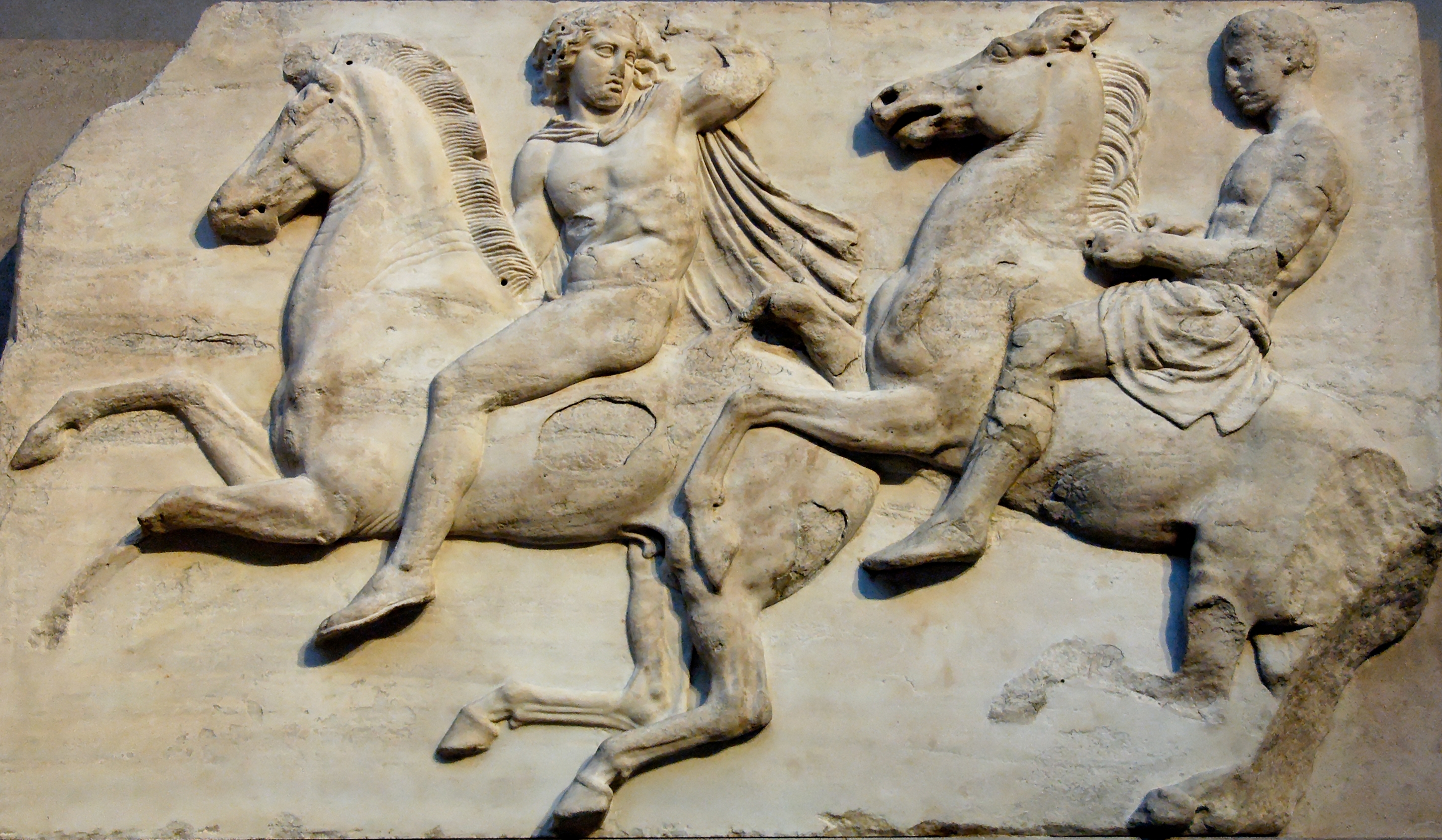|
Pediments Of The Parthenon
The pediments of the Parthenon are the two sets of statues (around fifty) in Pentelic marble originally located as the pedimental sculpture on the east and west facades of the Parthenon on the Acropolis of Athens. They were probably made by several artists, including Agoracritos. The master builder was probably Phidias. They were probably lifted into place by 432 BC, having been carved on the ground. Pausanias, a Greek geographer, described their subjects: to the east, the birth of Athena, and to the west the quarrel between her and Poseidon to become the tutelary deity of Athens. The pediments were very damaged by time and military conflicts. Considered the archetype of classical sculpture, or even the embodiment of ideal beauty, several of the statues were removed from the building by Lord Elgin's agents in the early nineteenth century and transported to the British Museum in London. Some statues and many fragments are kept at the Acropolis Museum in Athens. Other groups of ... [...More Info...] [...Related Items...] OR: [Wikipedia] [Google] [Baidu] |
Dionysos Pediment Parthenon BM
In ancient Greek religion and myth, Dionysus (; grc, Διόνυσος ) is the god of the grape-harvest, winemaking, orchards and fruit, vegetation, fertility, insanity, ritual madness, religious ecstasy, festivity, and theatre. The Romans called him Bacchus ( or ; grc, Βάκχος ) for a frenzy he is said to induce called ''bakkheia''. As Dionysus Eleutherios ("the liberator"), his wine, music, and ecstatic dance free his followers from self-conscious fear and care, and subvert the oppressive restraints of the powerful. His ''thyrsus'', a fennel-stem sceptre, sometimes wound with ivy and dripping with honey, is both a beneficent wand and a weapon used to destroy those who oppose his cult and the freedoms he represents. Those who partake of his mysteries are believed to become possessed and empowered by the god himself. His origins are uncertain, and his cults took many forms; some are described by ancient sources as Thracian, others as Greek. In Orphic religion, he was ... [...More Info...] [...Related Items...] OR: [Wikipedia] [Google] [Baidu] |
Parthenon Frieze
The Parthenon frieze is the high-relief Pentelic marble sculpture created to adorn the upper part of the Parthenon’s naos. It was sculpted between c. 443 and 437 BC, most likely under the direction of Pheidias. Of the 160 meters (524 ft) of the original frieze, 128 meters (420 ft) survives—some 80 percent. The rest is known only from the drawings attributed to French artist Jacques Carrey in 1674, thirteen years before the Venetian bombardment that ruined the temple. At present, the majority of the frieze is at the British Museum in London (forming the major part of the Elgin Marbles); the largest proportion of the rest is at the Acropolis Museum in Athens, and the remainder of fragments shared between six other institutions. Casts of the frieze may be found in the Beazley archive at the Ashmolean Museum at Oxford, at the Spurlock Museum in Urbana, in the Skulpturhalle at Basel and elsewhere. Construction Plutarch’s ''Life of Pericles'', 13.4–9, informs ... [...More Info...] [...Related Items...] OR: [Wikipedia] [Google] [Baidu] |
Metope (architecture)
In classical architecture, a metope (μετόπη) is a rectangular architectural element that fills the space between two triglyphs in a Doric order, Doric frieze, which is a decorative band of alternating triglyphs and metopes above the architrave of a building of the Doric order. Metopes often had painted or sculptural decoration; the most famous example are the 92 metopes of the Parthenon marbles some of which depict the battle between the Centaurs and the Lapiths. The painting on most metopes has been lost, but sufficient traces remain to allow a close idea of their original appearance. In terms of structure, metopes may be carved from a single block with a triglyph (or triglyphs), or they may be cut separately and slide into slots in the triglyph blocks as at the Temple of Aphaea. Sometimes the metopes and friezes were cut from different stone, so as to provide color contrast. Although they tend to be close to square in shape, some metopes are noticeably larger in heigh ... [...More Info...] [...Related Items...] OR: [Wikipedia] [Google] [Baidu] |


